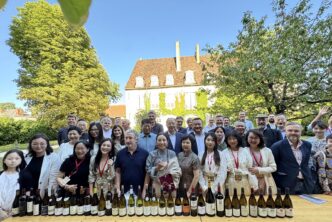Everyone who was visiting wineries, tasting, and writing about Canadian wines back in the early 1980s, which basically means Tony Aspler, John Schreiner, me, and very few others, have lots of stories to tell about Paul Bosc and Château des Charmes, his pioneering Ontario winery. My personal favourite amongst many similar stories is the following.

Few people today know that back in the 1980s, Bosc made some truly unique, trail-blazing Riesling wines. One such wine was the T.B.A., or “Totally Botrytis Affected” Riesling. Those who have gotten into Canadian wines only in the last twenty years or so can neither imagine the importance of such wines nor grasp the foresight of it took to make them, as well as what they meant to a then fledgling Ontario and Canadian wine industry (independently of how truly great or not they were). At the time, such a wine was simply not being made (outside of Inniskillin’s Riesling BA wine, or “Botrytis Affected”). Back then, most of those trying their hand at winemaking in Ontario concentrated their efforts on hybrid varieties and if anything else, on Icewines. As these things go, most of us didn’t realize it at the time, but to have someone in Ontario courageous enough to want to try and make wines like the great ones of the Mosel, the Rheingau and the Pfalz was not just visionary but all-important.
Already then, in the mid-1980s, I was actively bringing Canadian wines into not just Canadian homes but Europe too and holding tastings of them in wine shops and private homes everywhere, from Toronto to Montreal to Rome to Milan to Paris to London. Those were days: I know it’s hard to believe today, given the sorry world we live in, but can you imagine I used to board transatlantic jets to Europe carrying duffle bags with as many as 24 bottles of wine? Be it Jim Warren’s historic Merlot wines made when he was still at Stoney Ridge, Kaiser’s and Ziraldo’s first Vidal Icewines to see the light of day or Cave Spring’s proud vinifera bottlings, I gamely showcased Ontario and Canadian wines to knowledgeable wine people everywhere I could. I believed in Canada’s wines already then, convinced the country had the terroir and the passion to make world-class wines. But it was thanks to pioneers like Paul Bosc that I was able to do so, and that I not-so-slowly became convinced of that truth.
One fateful day back in 1987 or 1988 (memory fails me now), I held a guided tasting on Germanic grape varieties and their wines in what was then Rome’s best wine shop (no longer extant, unfortunately). This tasting was a replica of one I had conducted a few years earlier in Toronto where I had also served the same Ontario wine and vintage to a party of very knowledgeable wine friends who were collecting wines already in their early twenties. That evening, they had all liked the Mosel BAs and TBAs that were served better than the Ontario wine (and it would have been strange had they not, given the disparity in winemaking tradition between the two countries), but at the same time, they also all felt the Ontario wine held up its own.
Perhaps buoyed by such a result and by my own convictions, I proceeded to repeat the experiment in Rome, where the invitees were eight of the most knowledgeable and influential wine folks the city boasted in those days. Amongst the wine luminaries in attendance, a then Dean of an English and History department of one of the USA’s most famous and best-known universities on sabbatical in Rome and a huge Burgundy expert and collector; a major wine book author of the time; a soon to be very famous Italian wine producer then just starting out; two or three well-known local wine journalists; and other folks of a similar ilk. Besides a Silvaner Eiswein, a Müller-Thurgau Kabinett, an Ortega Trockenbeerenauslese, a Gewurztraminer Sélection de Grans Nobles and other such delights that I had gone sourcing from all over the world in what were my exuberant and happily excitable salad days, the tasting also lined up that Canadian wine I had served in Toronto only a year or two before: the Château des Charmes 1984 Riesling T.B.A. (the wine’s black label, which I still have in one of my wine label collections, carried the TBA letters written in a freestyle font and with the punctuation). When the time came that evening to imbibe that Canadian wine, I was so proud of what was in many ways an historic moment (to the best of my knowledge, nobody in Italy had EVER tasted a Canadian TBA wine before) that I thought of nothing better to say than “… And now I present you what is probably Canada’s best or second best TBA wine ever made” (and you notice how I hedged my bets by slipping in that “second-best”). No matter, I should have known better. Much better. One sip later, that pile of lovable but difficult wine snobs I had invited to the tasting literally laughed me out of the room; to this day, one of them still greets me by guffawing loudly and hilariously in front of everybody within earshot with a charming “…And here is the world wine expert of Canada’s second best-ever TBA”. Which, totally independently of how admirable and impressive his doing so may be (given that I come from a Sicilian background and that I know where he lives), tells you exactly what people thought of (or rather, didn’t think) of Canadian wines back in the 1980s. Those folks might have been wine snobs (OK, let’s just admit they were, and are), but at that stage of their wine lives they either didn’t or weren’t ready to take the Canadian wine seriously. Fortunately, not everyone in the room was wearing blinders and a number of very interesting, even useful, comments emerged in the after-tasting discussion. That day I learned a number of big lessons: lessons that formed and forged my career as a wine writer and expert. Some people, no matter how experienced and knowledgeable, remain impervious to the reality of what’s in their glass (because no, the Château des Charmes TBA was not a bad wine, and it did not deserve to be treated so cursorily). Independently of any wine’s real quality, with some people, labels will always matter.
But at the same time, by tasting the Château des Charmes TBA along with some other famous and less-famous wines of similar sweetness levels and style (all late-harvest wines, no air-dried stuff that day) and being neither jaded nor stupid in my desire to always listen, learn, and improve, I grasped clearly that Canada was on to something. Or at the very least, they were in Niagara: that evening, despite its ramifications that I am still paying for and enduring to this day (what would life be without friends who can and will make fun of you forever and ever) I became more convinced than ever before that Canada could make great wine. Simply put, Bosc’s T.B.A. was not the worst wine of the night, and was the equal of many German wines there (though admittedly not of those made with Riesling). But no matter: for the first time, it became apparent to me that Ontario’s sweet wines weren’t really pulling up the rear. And besides, as mentioned previously, I was very aware that others back in Ontario and the rest of Canada were starting to make what had the potential to become truly world-class wines already in the 1980s. But without doubt, my épanouissement and subsequent life’s work was, without doubt, partly the result of an individual linked to Algeria, to France, and to Canada, who had had the gumption, the vision, the desire, the passion, the insight and the energy to try and do something different. To go where (almost) nobody else had ever gone before. Thanks to his and similar trailblazing efforts, it is a “where” where we who love wine and not just of Ontario and of Canada all tread very happily today.
+++++++++++++++++++++++++++++++++++++++++++++++
Born in 1935, Paul Michel Bosc was a fifth-generation farmer, vinegrower and winemaker, as well as an Egyptian-Arabian horsebreeder who was born in French Algeria after his ancestors had moved there in the 1840s. After moving back to France where he graduated from the University of Burgundy in Dijon (France) with degrees in Viticulture and Oenology, he returned to Algeria where he was named General Manager of one of the country’s most successful wine cooperatives. He founded Château des Charmes winery (now into its seventh generation) in 1978 after arriving in Canada, like many others, in the 1960s (he came to Canada in 1963, working first at Quebec’s Liquor Control Board; then, in 1964, he moved to Niagara Falls to work at Château Gai, eventually becoming its Director of Research and Development. From the very beginning, Bosc believed in the importance of growing one’s own grapes and of estate-bottling, not to mention of eco-friendly farming practices (the Boscs are charter members of Sustainable Winemaking Ontario). Over the years, his Château des Charmes wines have won awards, medals, and high scores at national and international wine competitions. Furthermore, he has shone the spotlight on an important wine production area such as Niagara-on-the-Lake, and the vineyards of two distinct sub-appellations, the St. David’s Bench and Four Mile Creek DVA which give just as distinct wines. In his lifetime, for his very significant contributions to the modern Canadian wine industry, Bosc was also honoured with a doctorate from Brock University, The Order of Ontario, The Queen’s Golden and Diamond Jubilee Medals, the inaugural Canadian Vintners Association Award of Distinction and The Order of Canada. And as if all of that was not enough, in 2011 Paul was awarded the LCBO Special Recognition Award; and in 2017, the Grape Growers of Ontario Award of Merit.
He is survived by Pierre-André, Pierre-Jean and Alex; not just I, but everyone at the TerroirSense Wine Review extends their condolences.

 中文
中文



